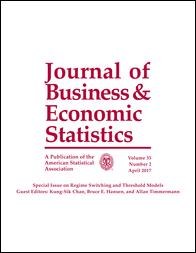
Azevedo, J., Koopman, S. and Rua, A. (2006). Tracking the business cycle of the Euro area: A multivariate model-based band-pass filter Journal of Business and Economic Statistics, 24(3):278--290.
-
Affiliated author
-
Publication year2006
-
JournalJournal of Business and Economic Statistics
This article proposes a multivariate bandpass filter based on the trend plus cycle decomposition model. The underlying multivariate dynamic factor model relies on specific formulations for trend and cycle components and produces smooth business cycle indicators with bandpass filter properties. Furthermore, cycle shifts for individual time series are incorporated as part of the multivariate model and estimated simultaneously with the remaining parameters. The inclusion of leading, coincident, and lagging variables for the measurement of the business cycle is therefore possible without a prior analysis of lead-lag relationships between economic variables. This method also permits the inclusion of time series recorded with mixed frequencies. For example, quarterly and monthly time series can be considered simultaneously without ad hoc interpolations. The multivariate approach leads to a business cycle indicator that is less subject to revisions than those produced by univariate niters. The reduction of revisions is a key feature in real-time assessment of the economy. Finally, the proposed method computes a growth indicator as a byproduct. The new approach of tracking business cycle and growth indicators is illustrated in detail for the Euro area. The analysis is based on nine key economic time series. {\textcopyright} 2006 American Statistical Association.